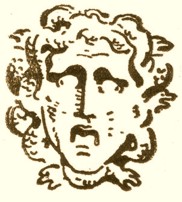![]()
![]()
CAMPAIGNS IN THE WEST
"He [the King of Kings] made the Republic of Rome tremble
before the prowess of his arms."
-- CICERO
H I S V I S I O N
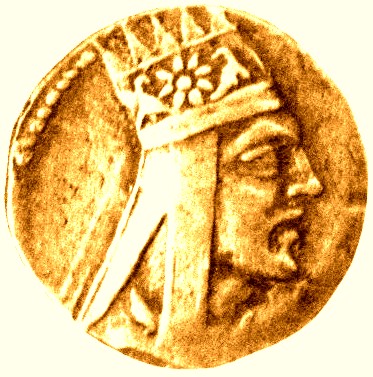
THE ROYAL DRAM OF THE KING OF KINGS. FEATURING THE
BUST OF
THE EMPEROR WITH THE ROYAL ARTAXIAD INSIGNIA ON THE SOLAR CROWN.
Written by Gevork Nazaryan
After reincorporating the state of Tsop'k' [Sophene] into Greater Armenia, Tigran turned his armies against Cappadocia, which had a mixed population of Armenians, Greeks and other ancient peoples who were to a large extent assimilated into the Hellenistic culture. Cappadocia favored the Romans and was providing the necessary ground for Roman entry into Eastern Asia Minor, Armenian Plateau and beyond. In 93 BC, the Armenian troops entered Cappadocia and dethroned king Ariobarzanes and crowned Gordios as the new king of Cappadocia, who pledged a close alliance with Greater Armenia and Pontus. Thus Tigran created a buffer zone between the encroaching Romans and the strengthening Armenian State. Tigran launched military campaigns and conquered Iberia [Georgia], Caucasian Albania to the east of Greater Armenia as well as the Caucasian tribes in the north, who often raided the northern frontier. Tigran wanted to control the important trade routes of the Near East -- stretching from Central Asia -- to Europe via Greater Armenia -- and -- Greater Armenia -- Mesopotamia -- Egypt cardinal directions. He placed the Arabic tribes of Skenites to guard the major trade centers and routes throughout Near East, particularly those of Syria and Mesopotamia. Tigran also signed military treaties and trade accords of cooperation with the Scytho-Iranian tribes of Central Asia. In order to solidify the alliance with the Pontic Kingdom, Tigran married the daughter of Mithridates, Cleopatra as a sign of affirmation of the Armeno - Pontic treaty.

A R T A X I A D Q U E E N WEARING THE
EIGHT-SPOKE ROYAL TIARA
WITH 8-POINTED STARS -- 3 ABOVE AND
3 BELOW
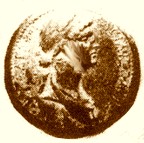
THE OBVERSE OF THE COIN OF ARMENIAN QUEEN IOTAPE
BEARING INSCRIPTION BACIΛICA IΩTAΠH ΦIΛAΔELΦΟC
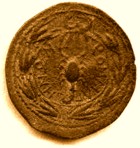
THE REVERSE -- A SCORPIO WITHIN
A LAUREL REEF BEARING THE INSCRIPTION OF
THE ARMENIAN KINGDOM OF COMMAGENE -- KOMMAΓHNΩN.
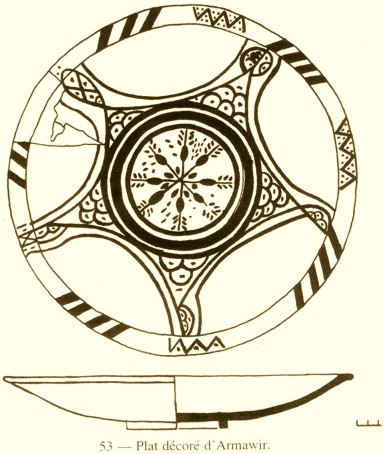
PLATE FROM ARMAVIR FROM THE ARTAXIAD ERA.
PENTAGONAL WITHIN CIRCLES CONTAINING EIGHT-FOLD FLOWER
TIPPED WITH TREE OF LIFEs [6 BRANCHES + 1 POLE/STEM=7].
THE STRIPED LINES IN THE PERIPHERAL CIRCLE INDICATE MOVEMENT
OF THE COSMIC WHEEL.

FINELY MADE CEREMONIAL CANDLE HOLDER. CLOSE UP OF THE BOTTOM
PORTION ON THE LEFT. NAXČAWAN, FIRST CENTURY BC.
THE CITY OF TIGRANAVAN WAS BUILT IN THE GOŁT‛AN PROVINCE,
NEAR NAXČAWAN [NAKHICHEVAN] HOME OF THE
RENOWNED
ARMENIAN BARD TROUBADOURS WHO SANG THE EPIC
ANCESTRAL SAGAS OF THE IMMORTAL HEROES.

SKETCH OF A CEREMONIAL PIPE FROM DRASXANAKERT USED
DURING THE CELEBRATIONS OF MITHRAIC MYSTERIES
[THESE MYSTERIES SPREAD FROM ARMENIA TO OTHER PARTS OF THE
ANCIENT WORLD INCLUDING THE BULL CULT IN PRE-DYNASTIC EGYPT
FROM PRIMORDIAL SITES LIKE GOBEKLI TEPE AND NEVALI CORI
WERE THE FIRST TEMPLES IN THE WORLD CARBON DATED TO CA. 9,000 BC
WERE UNEARTHED, THE LATER ELEUSINIAN MYSTERIES IN GREECE,
BACCHANALIA IN ROME AND BELTANE OF THE CELTIC DRUIDS].
NOTE THE SACRED ARMAN SYMBOL OF HEAVEN + EARTH UNION
[CONVERGING UP AND DOWN POINTING TRIANGLES] IN
VERTICAL AND HORIZONTAL ALIGNMENTS. THE FORMER
STOOD FOR MAN [WITH DIVINE SPARK] AND THE LATTER
STOOD FOR ETERNITY [SIGN OF INFINITI
∞].
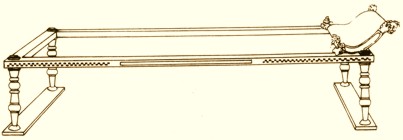
ELEGANTLY EXECUTED BENCH FROM MREN MADE DURING THE ARTAXIAD ERA.
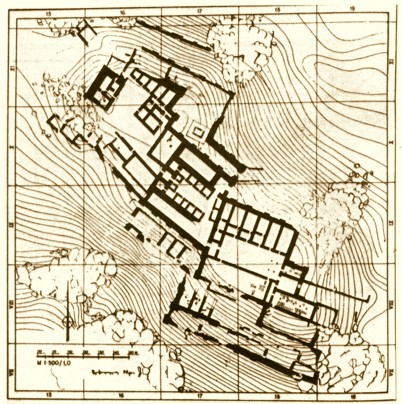
GENERAL PLAN OF THE OLD ORONTID CAPITAL ARMAVIR [ANCIENT ARGIŠTHINILI].
Tigran had four sons, the firstborn was killed while leading the charge of the Armenian Cavalry against the enemy. The second Zareh, was killed after an unsuccessful revolt against his father and tried with the help of some of the nobility wanting to assert their own power to overthrow Tigran. Tigran's third son -- Tigran the Young -- continued to fuel the revolt began by his elder brother. Later on this would greatly undermine Tigran II's authority within the Kingdom. King Tigran was forced to move troops from other countries such as Palestine and Commagene, to put down the rebellious nobles headed by Tigran the Young within the borders of Greater Armenia. Some historians suggest that Cleopatra, the mother of Tigran the Young, was responsible for provoking her sons to rebel against Tigran. Apparently because, as Cleopatra saw, Tigran II was not providing adequate assistance to her father -- Mithridates of Pontus -- who was virtually constantly at war with the Romans. Tigran could not commit large number of troops to Mithridates, because the Armenian military was already stretched too thin throughout the newly built Armenian Empire. Tigran needed large number of boarder troops to safeguard the southern and as well as northeastern borders of the Empire against -- the Parthians on one hand -- and -- the northern tribes on the other -- who constantly infiltrated the northern frontier during the destructive raids from the Caucasus mountains. The Parthians were hoping to once again take the leading position in the East and never forgave Tigran who stripped the Parthian monarch of his title as King of Kings, a title that Tigran II held to the end of his life.

T H E R E I S N O E A S T
O R W E S T ... W H E N ...
W A R R I O R S S T A N D F A C E T O F
A C E ...
ARMENIAN WARRIORS IN THE IMPERIAL ARMY WORE
THE MIHRIAN [MITHRAIC] SOLAR HELMETS MARKED WITH
THE 8 - POINTED STAR -- S Y M B O L O F T H E S U N G O D
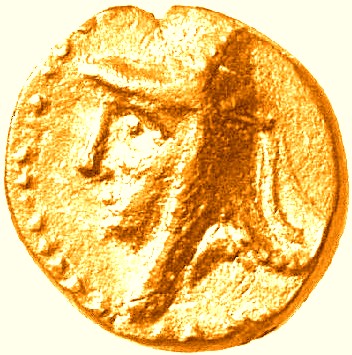
MITHRIDATES I CALLINICUS [96-70 BC] KING OF ARMENIAN KAMAX-COMMAGENE
OBVERSE: WEARING THE ARMENIAN TIARA BORDER OF DOTS.
COMMAGENE WAS INCORPORATED INTO GREATER ARMENIA BY THE KING OF KINGS.
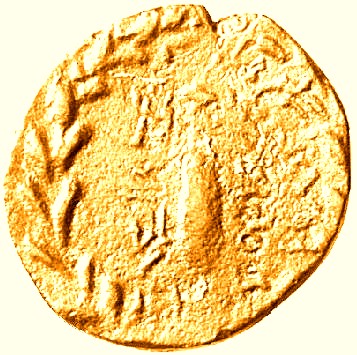
REVERSE: SLENDER CLUB, LEGEND ABOVE BASILEWS; BELOW
MIQPADA/TOW ALL WITHIN LAUREL WRATH.
After conquering the royal city of Ecbatana, including the province of Media and Atrpatakan, these kingdoms were also annexed by the Armenian Empire. By far the most distinguished and noblest son, was Tigran's youngest son -- Artavazd [Artavasdes]. Tigran's last son turned out to be a truly worthy successor [King Artavazd II] to his Father the Emperor. He was of noble character and a devotee to the culture of both Armenian and Classical heritage. Artavazd became renowned throughout the ancient world for his love of Hellenistic culture in general and Greek theatre in particular. Plutarch wrote that Artavasdes had written numerous plays and dramas for the theater of Artašat, that he himself had helped to establish. Artavazd also wrote the History of Armenia up to his own time, as well as deeper philosophical works, which unfortunately have not survived through the journey of time.

XIXTH CENTURY ENGRAVING OF THE GREAT ARMANEN HEATHEN SKY GOD
VAHAGN [BAAG] [PARALLEL OF TEYŠEBA
GOD OF THUNDER AND LIGHTNING].
In 91 BC, in line with the Armeno-Pontic alliance, the King of Kings passed the protectorate of Cappadocia to King Mithridates, who was in desperate need of raw material and manpower in order to build up his own forces. Mithridates was planning a long military campaign against the Romans. He wanted to drive the invaders out of Anatolia and Greece. Tigran knew that the Roman Republic was still growing and expanding. He believed in a bi-polar coexistence, with each power having and respecting each other's spheres of influence. The Near East would be in Armenian hands, while western Asia Minor up to Cilicia and Cappadocia would be in the Roman sphere. Mithridates, contrary to this policy, believed in uniting the newly created Armenian Empire, the Parthian State and other countries of the East to check the advancement of Roman legions. The Romans, promised a Pax Romana to the conquered peoples, offering stability and protection in exchange for loss of independence, along with heavy taxation. The heavy tolls that the farmers and the poor of the major Hellenistic cities had to pay often had tragic consequences when they were unable to pay their "fees" -- they became involuntarily slaves, often ending up somewhere far way from their land, toiling the Roman villas of their masters, or worst yet died in the Roman arenas, for the amusement of Roman masses. Tigran wanted to unite the Empire under already widely spread Hellenistic culture [a blend of ancient Eastern tradition with that of the West], a concept that was initiated by Alexander the Great three centuries earlier, and because of Alexander's enlightened policy had to a great extent struck root throughout the East.

ARMENIAN CAVALIERS REGROUP AFTER A SHORT PURSUIT.
Save the battle in 88 BC, the first stages of the Mithridatic wars, were successful in defeating the invading Roman legions by the combined Armeno-Pontic forces. The Romans headed by consular regates Manlius Maltinus and Aquillius, under the supreme command of pro consul Sulla, were crushed and sued for peace. The contemporary Roman historians were extremely bias and are regarded by many historians as not credible. However, one Roman historian, Justin wrote 'Having put them to flight, he [Tigran the Great] was received with great joy by the cities [in Cappadocia] in which he found a great quantity of gold and silver and vast warlike sources, laid up by the care of the former princes. Taking possession of these, he remitted the cities all sorts of debts, public and private, and granted them immunity from tribute for five years." [Justin XXXVIII.iii]. This shows that Tigran was wise enough to secure the support and toleration of the frontier states in order to create the necessary defense mechanism against further Roman encroachment. Tigran, like Mithridates wanted to see a strong East, united by the synthesis of Hellenistic [East -- West] culture. The danger of direct Roman authoritarian rule would be brutal towards the subjugated peoples. Numerous popular revolts, within Rome itself would result because of Roman heavy-handed excesses. In the 70's BC, under the leadership of the gladiator Spartacus, a Phrygian by nationality, who was forced to fight and die for the amusement of Romans, instigated a huge revolt. The "gladiator" uprising forced the Romans to focus their attention into their own "back yard," in the Italian peninsula, thus for the time being leaving their plans of invading the East.
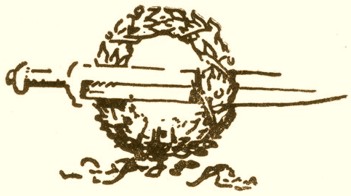
Unfortunately, the -- PAX ARMENICA -- The Alliance of the East, envisioned by Mithridates and supported by Tigran did not last long due to the fact the third most important power in the East -- the Parthians -- still bitter with the defeats suffered at the hands of Tigran's Army including the humiliating loss of Ecbatana -- were not interested in joining the Armeno-Pontic Alliance. On the contrary, they openly allied themselves with the Romans, serving as a Trojan-horse, a second front in the East. The Armenian State was very powerful during the 80s and 70s BC, however, within the Empire's border a revolt, headed by Tigran the Young was brewing. A number of naxarars unhappy with Tigran's strong leadership and centralized policy wanted to see Tigran toppled. As early as 92 BC, the Parthians conducted secret negations with the Romans asking for joint operation against Armenia and its ever growing might. During this period the Romans were still had their hands full with reorganizing and putting down the remaining pockets of resistance in the newly acquired possessions in Western Asia Minor, and as such were in no position to launch a military campaign against the Armenian might. During this period the leadership of the East was still firmly in Armenian hands... The Gods were merciful...
